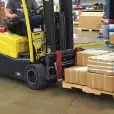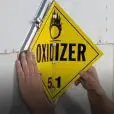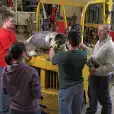
Industrial & Manufacturing
Employees in manufacturing face a variety of hazards and require training in numerous areas. Potential dangers include forklift operations, machine guarding, chemical handling operations, and fall hazards, among many others. To protect themselves, employees require knowledge of any hazards so they can recognize and report problems. Employers may need to develop written plans, train and evaluate workers, and provide daily oversight to ensure procedures are followed consistently. J. J. Keller provides the resources, information, services, and support you need to keep your workers safe.
Compliance Topics
Make sure you have the tools you need to comply with EPA and OSHA standards. See below for information and solutions on environmental, health, and safety topics.
Services and Technology for Industrial & Manufacturing Businesses
Industrial and manufacturing work environments pose a wide range of challenges and threats — heavy machinery, hazardous materials, complex processes — to employee safety and the success of your business. J. J. Keller is your one-stop source for the services you need to meet your many regulatory challenges.
- Chemical Management Service
- Industrial Hygiene Services
- OSHA Audits & Assessments
- OSHA Compliance Services
- OSHA Safety & Compliance Training
- Process Safety Management Services
- Environmental Audits & Assessments
- Environmental Compliance Services
- Environmental Reporting Services
- Hazmat Compliance Services
- Hazmat Multi-Modal Training: Ground, Air, Water
- Environmental Compliance Training
- Safe & Smart® On-site Forklift Operator Training & Trainer Certification
- Food Safety Consulting Services
- Human Resources Services
- Safety Management Suite
- Compliance Network
- Leave Manager
- J. J. Keller® Training
Is your organization going through a merger or acquisition? J. J. Keller can help you comply with key regulating authorities. Visit our Mergers & Acquisitions page to learn more.
Frequently Asked Questions
Chemicals
If the substance placed in the portable container is for immediate use by the employee who transfers the substance, then the portable container does not need to be labeled.
Immediate use would mean use during the employee's work shift. If, however, some of the substance will be left for use the next day or will be used by other employees either on the day of the transfer or during future work shifts, then the 5 gallon container must be labeled. See 29 CFR §1910.1200(f) for details.
No. They are not all exempt. The standard does not apply to non-hazardous chemicals. However, hazardous chemicals in the office are exempt only if they fall under one of the exemptions found under 29 CFR §1910.1200(b). For example, food, drugs, and cosmetics brought into the workplace for employee consumption are exempt. Therefore, rubbing alcohol in the first aid kit would not be covered. Also consumer products are exempted when used as you would at home. So correction fluid used to correct occasional mistakes or computer screen cleaner used infrequently would not be covered, but correction fluid or screen cleaner used for several hours per day every day would be covered. See the entire list of exemptions under 29 CFR §1910.1200(b).
The requirements in 40 CFR Part 370 apply to any facility that is required to prepare or have available a material safety data sheet (MSDS) for a hazardous chemical under OSHA.
The owner or operator of such a facility must submit an MSDS for all hazardous chemicals present at the facility at any one time in amounts equal to or greater than the minimum thresholds listed in 40 CFR 370.20(b).
The owner or operator of the facility must also submit an inventory form covering all hazardous chemicals that are present at their facility at any one time during the preceding calendar year in amounts equal to or greater than their thresholds. This Tier I inventory form must be submitted on or before March 1 of each year.
Food Quality & Safety
9 CFR §417.5(b) states that each entry on a record maintained under the HACCP plan shall be made at the time the specific event occurs and include the date and time recorded, and shall be signed or initialed by the establishment employee making the entry.
9 CFR §417.5(c) states that prior to shipping product, the establishment shall review the records associated with the production of that product to ensure that all critical limits were met and, if appropriate, corrective actions were taken, including the proper disposition of product. Where practicable, this review shall be conducted, dated, and signed by an individual who did not produce the record(s).
No, it is not necessary. It is acceptable for slaughter and simple processing to be covered with the same plan. It is also considered acceptable for these to be covered by separate plans.
Only one individual requires HACCP training to develop your plan. As stated in 9 CFR §417.7 the individual must successfully complete a course of instruction in the application of the seven HACCP principles in meat or poultry processing, including a segment on the development of a HACCP plan for a specific product and on record review. An individual that is HACCP trained but not an employee of your establishment can also help create your plan.
The Nutrition Labeling and Education Act of 1990 (NLEA) became law on November 8, 1990 and has led to significant changes in food labeling regulations. These regulations address three primary areas: nutrition labels, nutrient content claims, and health claims.
The new nutrition labeling regulations in 21 CFR §101.9 require nutrition labels on almost all packaged foods, revise the list of nutrients whose content levels are required to be shown on the nutrition label, adopt a new format for the nutrition label, and provide for more consistent serving sizes across product lines to reflect the amounts people actually eat. The basic nutrition label is to list 14 nutrients. The nutrients and the order in which they must be listed are as follows: calories, calories from fat, total fat, saturated fat, cholesterol, sodium, total carbohydrate, dietary fiber, sugars, protein, vitamin A, vitamin C, calcium, and iron. Other vitamins and minerals for which Reference Daily Intakes (RDI's) have been established must be declared if a claim is made about them or if they have been added as a nutrient supplement.
In addition to these mandatory nutrients, manufacturers may voluntarily choose to include calories from saturated fat and amounts of polyunsaturated fat, monounsaturated fat, potassium, soluble fiber, insoluble fiber, sugar alcohol, other carbohydrates, other vitamins and minerals for which RDIs have been established, and beta-carotene (as a percent of vitamin A). The amounts of nutrients declared in nutrition labels are for the product in the package, before consumer preparation. However, when foods are not intended to be consumed as packaged, manufacturers are encouraged to add another column of information specifying the percent Daily Value of a serving of the food "as consumed."
Nutrient content claims are those claims that describe the amount of a nutrient in the food (such as "sodium free" or "low fat"). These claims may not be made unless they are defined by FDA in regulations. General provisions for the use of nutrient content claims have been established in 21 CFR §101.13. Specific regulations have been issued that define the use of the terms "good source," "high," and "more" (21 CFR §101.54) and the terms "light" or "lite" (21 CFR §101.56). Separate regulations also cover the use of nutrient content claims for caloric content (21 CFR §101.60); sodium content (21 CFR §101.61); and fat, fatty acid, and cholesterol content (21 CFR §101.62). Various synonyms have also been established for the basic terms. Persons considering using nutrient content claims on the label or labeling of their products should refer to the above regulations for details on the requirements.
"Food additives" are substances which may by their intended uses become components of food, either directly or indirectly, or which may otherwise affect the characteristics of the food. The term specifically includes any substance intended for use in producing, manufacturing, packing, processing, preparing, treating, packaging, transporting, or holding the food, and any source of radiation intended for any such use under §201(s).
But the law excludes the following from the definition of a "food additive":
- Substances generally recognized as safe by qualified experts.
- Substances used in accordance with a previous approval ("prior sanction") under either the Federal Food, Drug, and Cosmetic Act, the Poultry Products Inspection Act (21 U.S.C. 451) or the Federal Meat Inspection Act (21 U.S.C. 601).
- Pesticide chemicals in or on raw agricultural products.
- Color additives.
- New animal drugs.
(Note: pesticide chemicals, color additives, and new animal drugs are subject to similar safety requirements of other sections of the law).
Manufacturers or importers not certain whether the chemicals or other ingredients used in their foods are subject to the safety clearance requirements of the Federal Food Drug Cosmetic Act (FFDCA) may seek an opinion from the Food and Drug Administration. If premarket approval is required, this may mean that studies, including animal feeding tests, will have to be carried out in accordance with recognized scientific procedures and the results submitted to the Food and Drug Administration for evaluation. General principles for evaluating the safety of food additives are published in 21 CFR §170.20. General instructions for preparing a food additive petition are in 21 §CFR 171.
The Food Allergen Labeling and Consumer Protection Act of 2004 (FALCPA) was enacted in August 2004 and addresses, among other issues, the labeling of foods that contain certain food allergens. All packaged foods regulated under the Federal Food, Drug, and Cosmetic Act (FFD&C Act) that are labeled on or after January 1, 2006 must comply with FALCPA's food allergen labeling requirements. Under FALCPA, a "major food allergen" is an ingredient that is one of the following foods, is from one of the following food groups, or is an ingredient that contains protein derived from one of the following:
- Milk
- Egg
- Fish
- Crustacean shellfish
- Tree nuts
- Wheat
- Peanuts
- Soybeans
Domestic persons (partnerships, corporations, associations, and individuals) that manufacture, process, pack, transport, distribute, receive, hold or import food; foreign persons that transport food in the U.S.; and persons who place food directly in contact with its finished container.
Industrial Safety/Health
No, 29 CFR §1910.144(a)(3) was not meant to state directly or by implication that all permanent handrails are painted yellow.
Yes and No. Caution signs can be posted to indicate a possible hazard against which proper precautions should be taken. If the employer determines that the nature of the hazard is such that failure to designate it may lead to an accidental injury, then a sign in accordance with 29 CFR §1910.145 or other effective means, like proper training, is required. Otherwise, the sign or other effective means is optional.
OSHA's general industry regulations on machine guarding or hand and portable power tools do not specifically prohibit employees from wearing jewelry or loose clothing.
In the general industry electrical standards, §1910.333 is on selection and use of work practices. Paragraph (c) is on working on or near exposed energized parts. Section (c)(8) states: "Conductive articles of jewelry and clothing (such as watch bands, bracelets, rings, key chains, necklaces, metalized aprons, cloth with conductive thread, or metal headgear) may not be worn if they might contact exposed energized parts. However, such articles may be worn if they are rendered nonconductive by covering, wrapping, or other insulating means."
In the Powered Industrial Truck regulation (§1910.178), paragraph (g) is on changing and charging storage batteries. Section (g)(12) states that "Tools and other metallic objects shall be kept away from the top of uncovered batteries."
OSHA has published a booklet, Hand and Power Tools (OSHA 3080), where page 4 states, "Wear proper apparel for the task. Loose clothing, ties, or jewelry can become caught in moving parts."
In another publication, Concepts & Techniques Of Machine Safeguarding (OSHA 3067), OSHA includes a Machine Guarding Checklist where one of the items under the heading Protective Equipment and Proper Clothing is, "Is the operator dressed safely for the job (i.e., no loose-fitting clothing or jewelry)?" In the last paragraph of chapter one, Basics of Machine Safeguarding, this publication states, "Other parts of the worker's clothing may present additional safety hazards. For example, loose-fitting shirts might possibly become entangled in rotating spindles or other kinds of moving machinery. Jewelry, such as bracelets and rings, can catch on machine parts or stock and lead to serious injury by pulling a hand into the danger area."
Under Section 5 of the OSH Act (the General Duty clause):
a) Each employer -
(1) shall furnish to each of his employees employment and a place of employment which are free from recognized hazards that are causing or are likely to cause death or serious physical harm to his employees;
(2) shall comply with occupational safety and health standards promulgated under this Act.
If the employer has recognized that wearing loose chains, jewelry, loose clothing, or other items is a hazard likely to cause serious physical harm, he has an obligation to address this hazard under the General Duty clause.
No, it does not meet OSHA requirements. Fire extinguishers must be at the jobsite and in numbers required by the OSHA regulations at 29 CFR §1926.150.
Records
Yes and no. All companies with 11 or more employees are required to have a written emergency action plan according to 29 CFR §1910.38(a). However, if a company has 10 or fewer employees, it has the option to skip the written plan and simply tell its employees its emergency action plan. All companies must have an emergency action plan, just certain companies do not have to put it in writing.
First of all, congratulations for developing the policies and procedures. There is much evidence to suggest that workplace violence is largely preventable through the development and implementation of specific policies and procedures. To be effective, however, they must discourage all types of workplace violence, and they must also encourage employees to come forward in the event that they are victims of, or witnesses to, any prohibited behavior.
At a minimum, your company's workplace violence policies and procedures should include the following:
- A statement that your company will not tolerate workplace violence of any kind;
- A description of prohibited behaviors and actions;
- Detailed procedures for reporting and investigating alleged instances of such behavior;
- Measures that will be taken to ensure confidentiality;
- Reassurance that retaliation for reporting an incident will not go unpunished;
- Disciplinary action that will be imposed for engaging in prohibited behavior, as well as for retaliating against another employee;
- Efforts that will be made to communicate company policy; and
- Methods that will be used to monitor workplace security.
To be effective, policies and procedures must be...
- Appropriate for the workplace;
- Easily understood by all employees;
- Revised, as necessary, to address changing conditions; and
- Reviewed with employees on a regular basis.
There is no one standard length of time to keep training records for all OSHA regulations. Unlike employee exposure records that must be retained for 30 years and medical records that must be retained for the time of employment plus 30 years (under 29 CFR §1910.1020), training record retention varies from regulation to regulation. Here are some examples:
29 CFR §1910.1030 (Bloodborne pathogens) - requires retraining at least annually and a written training record that must be retained for 3 years.
29 CFR §1910.134 (Respiratory protection) - requires retraining at least annually, but no specific written training record is required. Written fit testing records must be retained until the next test takes place.
29 CFR §1910.119 (Process safety management) - requires retraining at least every 3 years and a written training record. No training record retention time is specified.
29 CFR §1910.1200 (Hazard communication) - requires retraining as new hazards are introduced, but no specific written training record is required.
29 CFR §1910.132 (General requirements for personal protective equipment) - requires retraining as necessary and a written training certification. No training record retention time is specified.
29 CFR §1910.147 (Lockout/tagout) - requires retraining as necessary and a written training certification. No training record retention time is specified.
29 CFR §1910.146 (Permit-required confined spaces) - requires retraining as necessary and a written training certification. No training record retention time is specified. Cancelled entry permits are required to be retained for 1 year.
29 CFR §1910.178 (Powered industrial trucks) - requires an operator evaluation at least once every 3 years and a written training and evaluation certification. No training or evaluation record retention time is specified.
When training records are required, it would be best to always have them available. Consider keeping all training records during the worker's full period of employment. Your company may even set a policy to retain training records for a period after employment has been terminated. When written training records are not required, your company may still want to prepare them as a way to help keep your safety training program organized.
Training
It depends upon what the employer wants their employees (drivers) to do. There is no regulation that requires drivers to have HAZWOPER training.
HAZWOPER standard involves employees who are engaged in the following operations:
- Clean up operations that are conducted at uncontrolled hazardous waste sites. These operations are required by a governmental body, whether federal, state, local or other involving hazardous substances.
- Corrective actions involving cleanup operations at sites covered by Resource Conservation and Recovery Act of 1976 (RCRA).
- Voluntary cleanup operations at sites recognized by federal, state, local, or other governmental body as uncontrolled hazardous waste sites. Operations involving hazardous wastes that are conducted at treatment, storage, and disposal facilities regulated by Title 40 CFR Parts 264 and 265 pursuant to RCRA, or by agencies under agreement with EPA to implement RCRA regulations.
- Emergency response operations for releases of, or substantial threats of release of, hazardous substances regardless of the location of the hazard.
A driver would most likely fall under the last category. Keep in mind that the definition of "emergency response" talks of incidental releases such that "Responses to incidental releases of hazardous substances where the substance can be absorbed, neutralized, or otherwise controlled at the time of release by employees in the immediate release area, or by maintenance personnel are not considered to be emergency responses within the scope of this standard."
Paragraph (j) of the §1910.120 HAZWOPER regulation talks about handling drums and containers. In 1910.120(i)(1)(vii), OSHA says: "U.S. Department of Transportation specified salvage drums or containers and suitable quantities of proper absorbent shall be kept available and used in areas where spills, leaks, or ruptures may occur." In 1910.120(i)(1)(viii), OSHA says: "Where major spills may occur, a spill containment program, which is part of the employer's safety and health program required in paragraph (b) of this section, shall be implemented to contain and isolate the entire volume of the hazardous substance being transferred."
A spill would more than likely not be large if it is to be cleaned up by the driver.
If it is a large spill that becomes an uncontrolled HAZWOPER site, specially trained emergency response crews are usually called in.
Generally, once the hazardous substance leaves a site for transport, it is no longer covered under OSHA, but rather it is under the jurisdiction of the DOT. HAZWOPER training is not required unless drivers will be undertaking the task of cleaning up the site, and this is very involved. If a spill constitutes a HAZWOPER site, it usually involves functions from maintaining site security through decontamination. One or two drivers would not be enough to accomplish all that is involved.
Again, it all depends on how involved the employer wishes his drivers to be.
The regulation covering fire extinguishers in California workplaces is found in Title 8, Chapter 4, Subchapter 7, Group 27, Article 157, paragraph (g):
- (g) Training and Education
- (g)(1) Where the employer has provided portable fire extinguishers for employee use in the workplace, the employer shall also provide an educational program to familiarize employees with the general principles of fire extinguisher use and the hazards involved with incipient stage fire fighting.
- (g)(2) The employer shall provide the education required in subsection (g)(1) of this Section upon initial employment and at least annually thereafter.
- (g)(3) The employer shall provide employees who have been designated to use fire-fighting equipment as part of an emergency action plan with training in the use of the appropriate equipment.
- (g)(4) The employer shall provide the training required in subsection (g)(3) of this Section upon initial assignment to the designated group of employees and at least annually thereafter.
As most safety trainers are aware, safety training does not simply involve inviting a group of workers to a meeting on the safety topic of the month. It involves planning, preparation or development, and evaluation. But even before you get to the planning point of your program, you need to do some preliminary legwork, or analysis, to determine when training is the appropriate organizational response to a problem, issue, or need. So, before you commit to a training program, analyze organizational needs and specific problems, and review regulatory requirements for training.
Analysts use surveys, interviews, observations, or a combination of these to determine possible training needs. Managers, line supervisors, or workers might be asked questions seeking information on workplace accidents and "near misses," product quality, production efficiency, and on whatever else could point to areas where safety training or engineering/administrative control is needed.
When employees are not performing their jobs safely, it is often assumed that training will bring them up to speed. However, it is possible that other actions (such as hazard abatement or the implementation of engineering controls) would enable employees to perform safely on the job.
Problems that can be addressed effectively by training include those that arise from a lack of knowledge of a work process, unfamiliarity with equipment, or incorrect execution of a task. Training is less effective (but still can be used) for problems arising from an employee's lack of motivation or lack of attention to the job. Whatever its purpose, training is most effective when designed in relation to the goals of the employer's total safety and health program.
Ideally, safety and health training should be provided before problems or accidents occur. This training would cover both general safety and health rules and work procedures, and would be repeated if an accident or near miss incident occurs.
Although OSHA is moving towards safety training requirements that are "performance-oriented," that is, requiring training when certain indicators appear, some regulations still have annual retraining specifications built in. The following citations include annual retraining requirements:
- Access to employee exposure and medical records - 29 CFR §1910.1020(g)(1).
- Bloodborne pathogens - 29 CFR §1030(e)(2)(ii)(M) and (g)(2)(ii)(C).
- HAZWOPER - 20 CFR §1910.120(e)(8); (p)(7)(i) & (ii); (p)(8)(ii)(C); (q)(5); (q)(8)(i); Appendix C.2 (Training); and 29 CFR §1926.65 (same sections).
- Fire brigades - 29 CFR §1910.156(c)(2) and Appendix A, paragraph 5.
- Fixed extinguishing systems - 29 CFR §1910.160(b)(10).
- Grain handling facilities - 29 CFR §1910.272(e)(1).
- Mechanical power presses - 29 CFR §1910.217(h)(13)(i).
- Occupational noise - 29 CFR §1910.95(k)(2).
- Permit-required confined space - 20 CFR §1910.146(k)(2)(iv)-(rescue).
- Portable fire extinguishers - 29 CFR §1910.157(g)(2) & (4).
- Respiratory protection - 29 CFR §1910.134(k)(5).
In addition, the chemical-specific regulations in Subpart Z* require annual retraining. The only chemical-specific Subpart Z regulations that do not require annual retraining are §1910.1002-coal tar pitch volatiles, §1910.1052-methylene chloride, and §1910.1096-ionizing radiation (but, the employer must advise employees of their ionizing radiation monitoring results annually).
NOTE: The chemical-specific regulations in Subpart Z that require annual retraining are §1910.1001-Asbestos; §1910.1003 through §1910.1016-13 Carcinogens; §1910.1017-Vinyl chloride; §1910.1018-Inorganic arsenic; §1910.1025-Lead; §1910.1027-Cadmium; §1910.1028-Benzene; §1910.1029-Coke oven emissions; §1910.1043-Cotton dust; §1910.1044-1,2-dibromo-3-chloropropane; §1910.1045-Acrylonitrile; §1910.1047-Ethylene oxide; §1910.1048-Formaldehyde; §1910.1050-Methylenedianiline; and §1910.1051-1,3-Butadiene.
With respect to forklift training, OSHA has adopted a performance-oriented approach to the qualifications of trainers and evaluators. The trainer and evaluator must be a person or persons with the requisite knowledge, training, and experience to conduct the required training and evaluations. An employer could assign a current employee, employ such instructors/evaluators, or contract with an outside service to conduct the required training and evaluation. Instructors/evaluators do not have to be a qualified or competent person as the terms are defined in the construction regulations.











